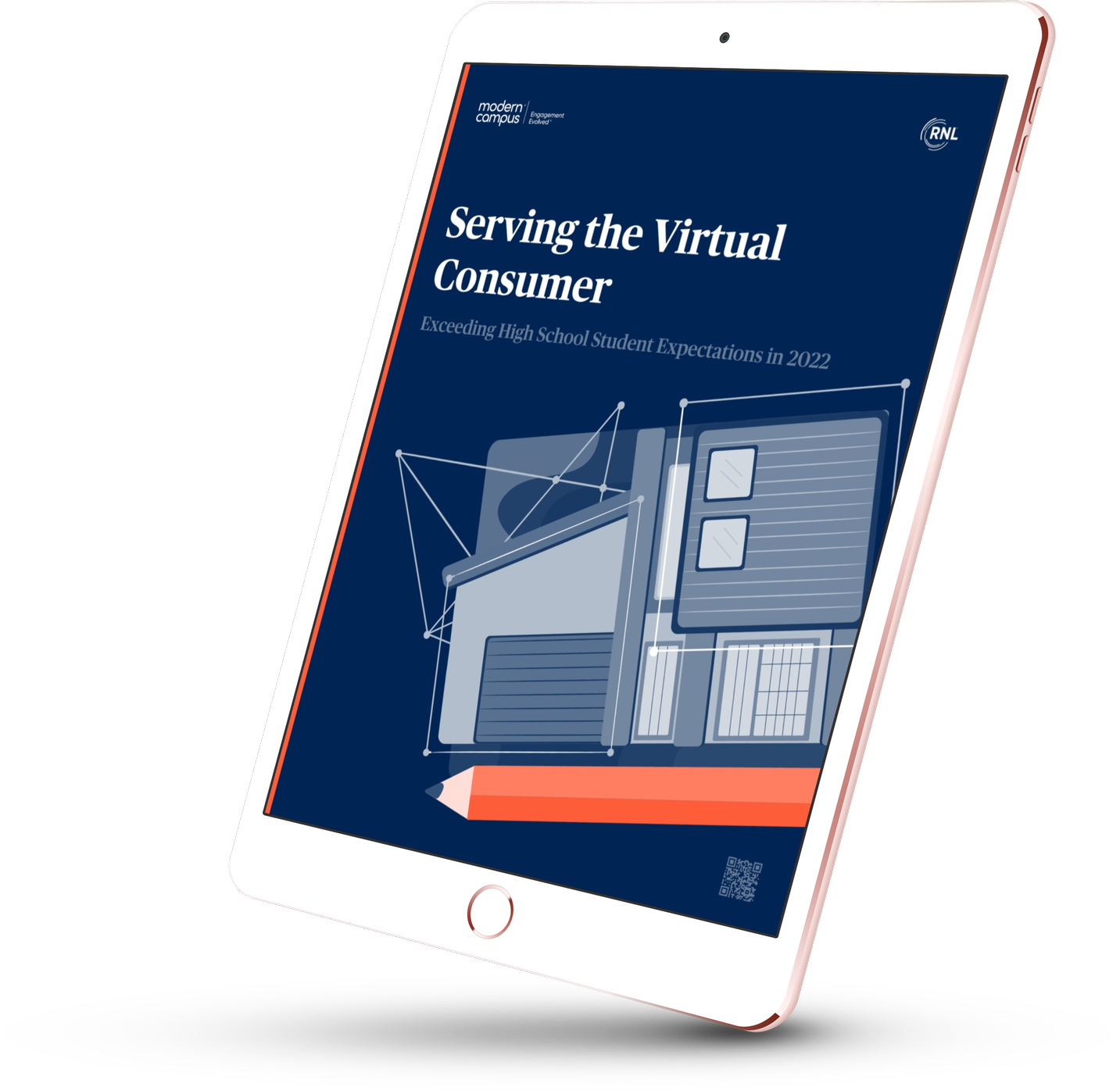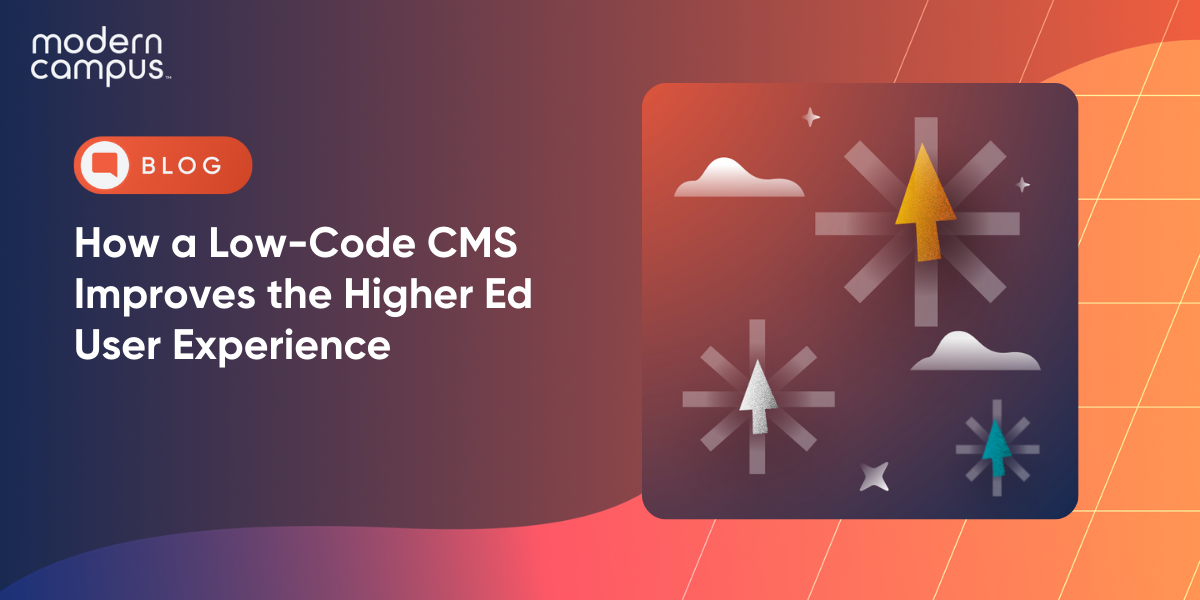5 Ways to Design Your College Website to Meet Students’ Expectations
“An institution’s website doesn't solely exist to look pretty. It’s there to accomplish very specific and critical goals—one of the most important being recruitment. It is critical to provide students with informative and engaging content across websites and an excellent user experience.”
– Marriel Hardy | Chief Communications Officer, Coahoma Community College
Your website is the front door to your institution. It’s one of the first places your prospective students visit, and serves as an important touchpoint in their enrollment decision.
So the website has to be both attractive and informative.
It has to share the very best of what your institution has to offer in an easily-navigable way.
Critically, it must deliver the right information to the right prospective student at the right time—offering the personalization today’s digital consumer expects.
A recent study developed by Modern Campus and based on research conducted in partnership with Ruffalo Noel Levitz (RNL) found some interesting insights into students’ behavior and expectations when they plan for college. These insights can help you refine and update your institutional website to better target prospective students.
In this blog post, we’ve highlighted the top five ways students look at college websites and discussed how you can refine your website design and structure to proactively offer what students want.
1. Make your website mobile friendly
The study shows that students start planning for college as early as 9th grade. More than 60% of them have started their college planning by the time they start 10th grade.
On average, Gen Z starts using a smartphone—their primary digital device—when they’re in7th grade. Colleges and universities need to have their websites optimized for mobile and personalized for students as young as 14 years old.
Talking about website strategy, Joseph Sallustio, Senior Vice President for Lindenwood Global, Lindenwood University and his co-authors Jay Casper and Clarence Bowman (both marketing professionals) say it’s critical to optimize your website for your consumers.
“An important question to ask yourself is, “What types of devices will most traffic arrive from?” If you have a site with 90% mobile and 10% desktop, then it might be prudent to design the site for mobile optimization,” they write in The EvoLLLution. “We have seen many well-designed desktop sites that did not translate well to mobile, so be careful when deciding which design will help you the most.”
2. Show program catalogs and career pathways on your website
The study shows that academics (programs, majors, minors, etc.) and the cost of education are the top priorities for students planning for higher education.
Therefore, colleges need to leverage smart and digital catalog management technology that can transform their catalogs into strong marketing tools – optimized for search engines and mobile devices. Integrating career pathways goes a step further and can help prospective students immediately calculate the return on their education investment—especially critical in an era where students are critical of the value of a college education.
“It’s important for a student to understand where a degree program can take them, but at times it’s hard for our students to make the connections between the degree programs and the career that it leads to. So, they need the visibility of a career pathway stemming out of a particular course or program.” says Melony Martinez, Director of Marketing and Public Relations at National Park College.
3. Personalize your website for known visitors
One fascinating insight from the survey was that the secondary factors students explore differ greatly as they progress from 9th to 12th grade. While Academics and Cost remain the most important priorities regardless of age, 9th graders are particularly interested in community life, activities, and athletics. Similarly, 10th graders are more interested in college rankings than any other age group.
Therefore, you need to ensure that your website is leveraging data from the CRM to feed the right information to the right learners. If a prospective 9th grade student is visiting the website, leverage personalization features to highlight campus activities and co-curriculars right on the homepage. If a 10th grader is visiting the website, make sure any recent rankings or awards are front and center.
Eric Hazen, Director of Digital Marketing at Ferris State University, has been leveraging Modern Campus CMS to deliver personalized experiences to known website visitors, talking about which he says,
“The personalized content block we’re currently running on our homepage for new student orientation has a click-through rate of 30.8% right now—versus the default of 0.58%. Our jaws are currently on the floor.”
In short, higher education marketers should leverage their websites to highlight information that will engage different audiences in the most relevant way possible.
4. Personalize your website for parents
Parents have a major impact on the way prospect students plan for college. In fact, 70% of students said their enrollment decisions are influenced by their parents or guardians.
Colleges need to target parents early to build brand awareness via text, email, and digital marketing channels. Keep engaging them throughout the funnel when they are not only in the position to influence their own student, but also to influence other parents.
Additionally, colleges can use a form strategy to have website visitors identify themselves as prospective students, parents, or counselors. This can ensure your website personalization is set up to share the data points and information most relevant to each website visitor.
“When I look at our homepage, I often think, this is the content for the prospective student, this is for the parent and this for the influencer,” Hazen said in an interview with The EvoLLLution. “We’re excited about how the shortcuts that the personalization tools Modern Campus is bringing out are going to give us the flexibility to serve our many, many audiences.”
5. Show high-quality virtual tours on your website
The study shows that one third of students are willing to travel more than 500 miles to pursue higher education, and that 63% of students consider traveling out-of-state for college. Naturally, all of them won’t visit the out-of-state colleges physically to see their campuses. Therefore, they take virtual tours.
Almost half of the students surveyed have participated in virtual tours of colleges and universities. Almost seven out of ten signed up for a virtual tour via the college website and 71% of them expressed satisfaction with the virtual tour.
Therefore, colleges and universities need to ensure that their websites offer high-quality virtual tours to prospective students, especially to the out-of-state students.
Make Sure Your Website Delivers Students the Digital Experience They Expect
Delivering a great digital experience starts with the website, and it’s essential that you have the right tools in place. Your higher education website needs to be built on a platform that delivers the student-centricity that modern colleges and universities promise.
If you’re thinking about finding a new CMS to build your website around, our CMS Buyers’ Guide will give you the knowledge and strategies you need to find the platform that’s right for you!

Website Design & Personalization
Last updated: August 18, 2022



